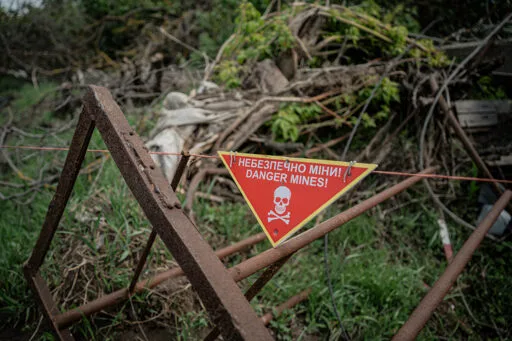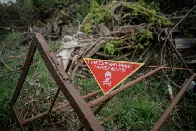Ukraine’s Contaminated Land: Clearing Landmines With Rakes, Tractors and Drones
Ukraine’s Contaminated Land: Clearing Landmines With Rakes, Tractors and Drones

This story was produced in partnership with Agence France-Presse (AFP). In a field near the small town of Bezymenne in southern Ukraine, Viktoria Shynkar carefully picks out a narrow path through the overgrown grass in front of her. This small corridor of farmland in Mykolaiv Oblast will be checked...

...
[Deminer Viktoria] Shynkar and her colleagues, who work for the demining charity the Halo Trust, uncovered 243 TM-62 Soviet-designed anti-tank mines left by the Russian army in a neighbouring field.
A chunky and intimidating 32-centimetres in diameter and 13-cm-wide, the TM-62 contains 7.5 kilos of TNT and can puncture a tank if triggered.
The presence of landmines and other unexploded ordnance is a significant issue in Ukraine, impacting civilians and Ukraine’s agricultural industry – a major employer and source of income to the country.
...
Established by the [Ukrainian] Ministry of Defence, the country’s National Mine Action Centre (NMAC) has produced a map that highlights areas it confirms as hazardous, are suspected of being hazardous as well as those that have been cleared or checked for hazards. [The map can be seen in the linked article.]
...
The information is collated from over 80 demining groups operating in the country, which employ people like Shynkar. They collect data from the field and share it with the NMAC who upload it to this map made using the IMSMA platform produced by the Geneva International Centre for Humanitarian Demining.
Yet the data the NMAC map contains, while significant, is only partial.
For example, it only creates a picture for the Ukrainian side of the front line, and just parts of it at that, with an area 20 kilometres from the frontline inaccessible to demining groups. Those same demining groups are also not operating in Russian-controlled regions, making the overall picture even less clear.
Furthermore, just because an area may be noted as not being impacted in landmine datasets doesn’t mean that it is not at risk from mines or other explosive ordnance that may not have detonated on impact. Some may simply not have been found yet.
...
The country’s Agriculture Minister, Vitaliy Koval, ... stated that just over 123,000 km2 of land still needs to be assessed for the presence of landmines or explosives. That is a huge area, almost the same size as Greece, much of which remains inaccessible along the 1,500 km frontline.
...
As of May 31, 2025, [Deminer Viktoria Shynkar] had been with the Halo Trust for a year. It’s a position she feels comfortable in despite the danger that comes with the job.
“Not once have I regretted [taking on the work], not at all,” she says. “I like the job very much. Because there are many good people here, and I feel like I’m resting at work.”
On top of that, the impact of what she is doing gives her satisfaction.
“There’s a lot of contamination … and farmers can’t work, can’t grow crops,” she says.
“We really need this, so I want to help however I can, so that our country can prosper.”
